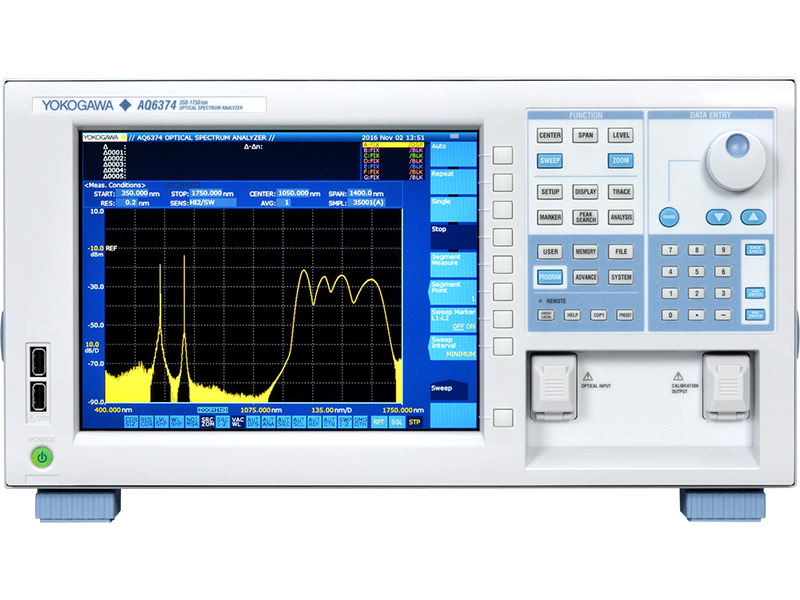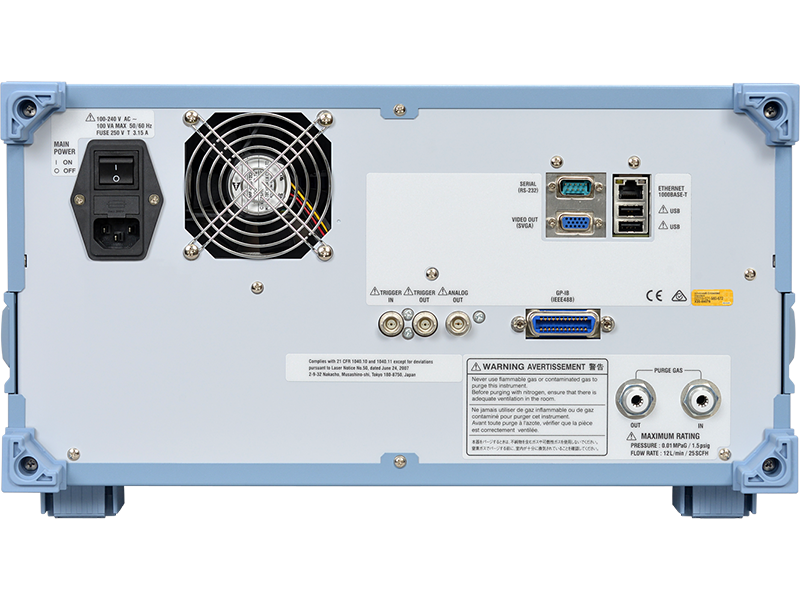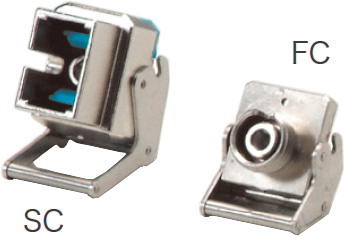AQ6374 Wide Range Optical Spectrum Analyzer 350 – 1750 nm (DISCONTINUED)
Optical Spectrum Analyzer Function
The AQ6374 Wide Range Optical Spectrum Analyzer covers wavelengths from 350 to 1750 nm including visible lights (380 to 780 nm) and the telecommunication wavelengths.
Optical Spectrum Analyzer Working Principle
Spectrum analyzers measure signals' spectrum content using a vertical (amplitude) and horizontal sweep (frequency) of an oscilloscope.
World-Class Optical Performance
- Wavelength range: 350 to 1750nm
- High wavelength accuracy: ±0.05nm
- High wavelength resolution: 0.05 to 10 nm
- Wide dynamic range: 60dB (peak ±1.0nm)
- Wide level range: +20 to -80dBm
- Fast measurement: 0.5 sec. (100nm span)
Wavelength Resolution Settings:
There are 8 wavelength resolution settings: 0.05 to 10 nm
to enable the user to choose the best value according to the
device/system under test.
Measurable Level Range:
The wide measurable level range is from−80 to +20 dBm. This is suitable to measure high power as well as low power sources used in different fields of application.
Wavelength accuracy:
The ±0.05 nm wavelength accuracy can be maintained by the calibration using the built-in reference light source or an external light source including HeNe laser and Argon light source.
Fast measurement:
The instrument takes only 0.5 s for 100 nm span (with sensitivity set to NORM_AUTO).
Number of sampling: 100001
The number of wavelength samples has been doubled. One sweep can measure a wider wavelength range at high resolution.
Mouse and keyboard operation
More than 30 years of feedback from users have enabled intuitive and easy-to-use front panel operation. Mouse functionality provides ease of use for navigation and the keyboard helps to enter numbers and file names.

Trace zooming
- Change display conditions, such as center wavelength and span, by clicking and dragging the mouse.
- Enlarge your area of interest instantly and move it at will.
- No need for another measurement to modify the display conditions.

Trace calculation and analysis
Seven individual traces
- Simultaneous multi-trace display
- Calculation between traces (subtraction between traces)
- Max/Min Hold function
USB ports
Four USB ports in total available on front and back facilitate the use of external devices such as a mouse, keyboard, external hard drives and memory sticks.

Thumbnail file preview
The thumbnail allows an easy and fast route to find a particular file out of many files in internal and external storage.
All-at once trace filing
A time-saving feature which allows to save all seven traces in one file at once. Files are saved in CSV format and can be easily manipulated with a PC application software.
16 data analysis functions
- WDM (OSNR) analysis
- Optical Fiber Amplifier analysis
- DFB-LD analysis
- FP-LD (VCSEL) analysis
- LED analysis
- Spectral Width analysis
- Notch Width analysis
- SMSR analysis
- PMD analysis
- Optical Power analysis
- Color analysis
- Optical Filter analysis (PK, BTM, WDM-PK, WDM-BTM)
- Go/No-Go Judgment
Purge feature

Due to the high resolution and sensitivity of the AQ6374, it can actually detect the presence of water molecules in the air. The water vapor is detected in the upper Near-IR wavelength region and could overlap with or mask the spectral characteristics of the actual device under test in that particular region.
By continuously supplying a pure purge gas such as nitrogen to the monochromator through the ports on the back panel, the AQ6374 can reduce the influence of water vapor absorptions and provide more reliable and accurate measurements than ever before.
Built-in cut filter for high order diffracted light
Due to the diffractive technology used, the monochromator in some circumstances could generate high order diffracted light which appears at wavelengths equal to the integral multiple of input wavelengths.
The built-in calibration source
Ambient temperature change, vibrations and shock affect the measurement accuracy of high precision products like optical spectrum analyzers. We want our OSAs to be able to deliver always the precise measurements they were designed for, therefore our instruments are equipped with a light source for calibration.
Calibration process is fully automatic and takes only 2 minutes to complete. It includes:
- The Optical Alignment function, which automatically aligns the optical path in the monochromator to assure the level accuracy.
- The Wavelength Calibration function, which automatically calibrates the spectrum analyzer with the reference source to ensure the wavelength accuracy.

Data logging function
Records analysis results such as WDM analysis (OSNR, optical signal/noise ratio), distributed feedback laser diode (DFB-LD) analysis, and multi-peak measurements at up to 10000 points per channel with time stamps. Recorded data can be displayed in table and graphical forms. This function is useful for the long-term stability testing and temperature cycle testing of systems and devices. The optical spectrum of each measurement can also be stored for reviewing and troubleshooting.

Advanced marker function
Adds markers to obtain the power spectral density and the integrated power of a designated spectrum. This new feature makes it easy to get an OSNR value of the signal, whether modulated or not, directly from its spectrum.
Building automated test systems
Any model of the AQ6370 Series, thanks to the built-in Macro Programming Function, can perform automatic measurements and control external equipment through its remote interfaces.
GP-IB, RS-232 and Ethernet ports are available to have the instrument remotely controlled by a PC and to transfer standard SCPI-compatible or proprietary AQ6317- compatible commands. Also LabVIEW® drivers are available.
The AQ6370 Viewer

Real-time remote control
The AQ6370 Viewer is a software package, which replicates The OSA's screen on a PC and enables:
- Remote control and operation of the instrument
- Display, analyze and transfer the data acquired by the instrument on your remote PC
The AQ6370 Viewer is appreciated especially by:
- Production Managers, who can command the instrument and collect its measurement results from their office without physically going to the actual production line.
- Service Engineers, who can help their customers or colleagues by setting the instrument in the proper way, tuning it on the device/system they want to test.
Smoothing function
Reduces the noise on the measured spectrum.
Active component test
Characterization of laser sources
How do you use a spectrum analyzer? Today various light sources such as DFB-LD, FP-LD and VCSEL emitting in the visible light to mid-infrared wavelength region are mounted into many different devices/systems used in different areas of application, such as:
- Telecommunication: with glass fiber or plastic fiber
- Industrial: Barcode scanners, LiDAR surface scanners
- Consumer electronics: audio output of Hi-Fi audio systems, laser printers, computer mice

Characterization of sources used in laser Absorption Spectroscopy
Laser Absorption Spectroscopy is a measurement technique used to detect and measure the concentration of gases in the air, and in open or closed environment. The lasers used in Absorption Spectroscopy require excellent single-mode operation performance, which directly determines the limits of detection. Furthermore such lasers should produce a stable oscillation in the absorption region in order to achieve sensitive detection of the gas of interest. Most of the greenhouse gases, for example CO2, SO2, NOx and CH4, have strong absorption lines in the 2-3 μm wavelength region.
The lasers used in Absorption Spectroscopy are DFB-LD and VCSEL. Important parameters for evaluating the performance of these lasers are the Side Mode Suppression Ratio (which is the amplitude difference between the main mode and the side mode), and the Spontaneous Emission level (which is the magnitude of background noise light). Both parameters can be accurately and quickly measured by the AQ6375B and AQ6376.
Characterization of Supercontinuum light sources
Supercontinuum light is generated by promoting highly nonlinear optical processes in special materials, e.g. photonic crystal fiber, by pumping them with a mode-locked pulsed laser (typically a femtosecond Ti: Sapphire laser). Supercontinuum light can be best described as ‘broad as a lamp, bright as a laser’, in fact it matches the characteristics of incandescent and fluorescent lamps—i.e. very broad spectrum—with the characteristics of lasers—i.e. high spatial coherence and very high brightness, which enables optimum coupling to a fiber and outstanding single-mode beam quality.
The Supercontinuum light sources are nowadays finding applications in a diverse range of fields, including optical coherence tomography, frequency metrology, fluorescence lifetime imaging, optical communications, gas sensing and many others.
The AQ6370 series, thanks to its premium performance, are the ideal instruments to test and characterize Supercontinuum light sources during their pre and post production quality checks.

Passive component test
Visible LED test
The optical spectrum of visible LEDs used in lighting, signage, sensing and other applications can be measured and analyzed. By supporting the large core fiber input, AQ6373B and AQ6374 can efficiently get the LED light and measure its spectrum.The built-in Color Analysis function automatically evaluates the dominant wavelength and the chromatic coordinates of the source.

In conjunction with a broadband light source such as ASE, SLD, SC light source, the OSA can simply perform evaluation of passive devices such as WDM filters and FBG. Superb optical characteristics of the AQ6370 series enable higher resolution and wider dynamic range measurements. The built-in optical filter analysis function simultaneously reports peak/bottom wavelength, level, crosstalk, and ripple width.

Loss wavelength characterization of optical fibers
Loss values of optical fibers are different depending on wavelengths of propagating optical signals. These differences are caused by the absorption by optical fibers and the effect of Rayleigh scattering. The loss values vary by the materials and types of fibers: in the case of a quartz single mode fiber, a loss around 1.55 μm is about 0.2 dB/km, which is the smallest, and around 1.4 μm a large loss occurs due to water ions (OH). The loss wavelength characterization of this type of optical fibers requires measuring a wide range of wavelengths.
With the combination with a white light source, the AQ6374 efficiently characterizes the loss wavelength measuring a wide range of wavelengths. The loss value is displayed in terms of the loss per unit length of the optical fiber.

Characterization of Fiber Bragg Gratings
A Fiber Bragg Grating (FBG) is a type of distributed Bragg reflector constructed in a short segment of optical fiber that reflects particular wavelengths of light and transmits all the others. This is achieved by creating a periodic variation in the refractive index of the fiber core, which generates a wavelength specific dielectric mirror. A Fiber Bragg Grating can therefore be used as an inline optical filter to block certain wavelengths, or as a wavelength-specific reflector. The primary application of Fiber Bragg Gratings is in optical communications systems: they are specifically used as notch filters and they are also used in optical multiplexers and demultiplexers with an optical circulator, or optical add-drop multiplexer (OADM). Fiber Bragg Gratings tuned on 2-3 μm region are also used as direct sensing elements for strain and temperature in instrumentation applications such as seismology and in pressure sensors for extremely harsh environments. To characterize FBGs, the high wavelength resolution and high dynamic range of the AQ6370 series are indispensable.

Gas detection and concentration measurements
Used together with a broadband light source like Super Continuum (SC) or Super Luminescent Diode (SLD), the AQ6370 series can show the absorption spectrum of the gas mixture under test.

Hydrogen Cyanide absorption spectrum measurement
Front View

- High Resolution Display:
A large 10.4-inch SVGA LCD clearly displays detailed waveforms and numerical results. On-screen buttons facilitate the instrument setting by using the mouse. - Optical interfaces
The AQ6370D, AQ6374, AQ6375B and AQ6376 offer a universal type optical connector system for optical input and calibration output enabling direct coupling to popular styles of optical connectors. The connectors can be replaced by users. - Rotary knob
This multifunctional knob allows easy and quick adjustment of parameters and settings. - USER button:
Registering frequently used soft keys in the USER button allows execution of frequently used functions in a just a few steps. - USB:
USB ports to easily operate on the instrument using a mouse and a keyboard. - Macro programming button:
User can compile up to 64 programs (200 steps per program) to build-up automatic measurement systems.- No external PC is required.
- Easy to create test program by recording the user’s actual key strokes and parameter selections.
- Can control external equipment through the remote interfaces.
Rear View

- Trigger IN/Trigger OUT
Pulsed light measurement, Gate sampling - Analog OUT
Voltage output for a stability test w/oscilloscope - Serial (RS-232), Video OUT (SVGA)
Auxiliary interfaces - GP-IB (IEEE 488.1/488.2)
- Ethernet
- USB (2X)
- Purge gas IN/OUT
 |
Reduced emission of CO2 about 26% compared to the previous model. Results of Life Cycle Assessment Results of Life Cycle Assessment |
AQ9447 Connector Adapter
- AQ9447 Connector Adapters
- For optical input port
- AQ6370 Series Optical Spectrum Analyzer Accessories
Numerical Aperture Conversion Fiber
By connecting a GI 50 or GI 62.5 optical fiber with a relatively large NA to the NA Conversion Fiber, the NA Conversion Fiber reduces the loss that occurs at the input and improves the measurement dynamic range during passive device measurements and the stability of optical level measurements during active device measurements.
To accurately measure pulsed light using an optical spectrum analyzer (OSA), it is necessary to understand the characteristics of the OSA and select the appropriate measurement method and settings.
A new type of computer based on the theory of quantum mechanics, a quantum computer, is currently in development by researchers around the globe. The theory of quantum mechanics describes nature at the atomic and subatomic level. Quantum technology has the potential to build powerful tools that process information using the properties of atoms, photons, and electrons. These quantum computers could also address challenges of much greater complexity than what today's computers can solve, and help further advancements in science, technology, medicine, and more.
With countries spending billions of dollars, the race for who can produce the first practical, commercialized quantum computer is on. There are currently several approaches to build this sort of computer, and this all begins with creating and initializing quantum bits, also known as qubits.
Laval University is a research institution world renowned for optics and photonics technology research and training, and are the founders of The Center for Optics, Photonics, and Lasers (COPL).
The university's researchers needed a faster and more efficient and practical solution to measure the spectral performance of lasers and optics beyond traditional telecom wavelengths. To achieve this, they contacted Yokogawa Test&Measurement and collaborated to develop a breakthrough grating-based optical spectrum analyzer that could cover MWIR wavelengths up to 5.5 um. Click to learn how productivity in the research lab dramatically increased for precise characterization of laser sources, and active/passive optical components in the fields of communications, medical diagnosis, advanced optical sensing, and environmental and atmospheric sensing.
Instruction Manuals
- AQ6374 Optical Spectrum Analyzer User's Manual (15.4 MB)
- AQ6374 Optical Spectrum Analyzer Getting Start Guide (2.2 MB)
- AQ6374 Optical Spectrum Analyzer Remote Control User's Manual (2.9 MB)
Specifications
Software
- AQ6370 Viewer
- MATLAB Toolkit for AQ6370 series Optical Spectrum Analyzer
- Security update against the WannaCrypt/ WannaCry ransomware
- Remote monitor software for AQ6370C, AQ6150
- LabVIEW Drivers for AQ6370 series Optical Spectrum Analyzer ( NATIONAL INSTRUMENTS Web Page )
- Sample Program for OSA
Firmware
Drawings
- AQ6374 Optical Spectrum Analyzer (556 KB)
How-tos
See how to use the in-built calibration on your optical spectrum analyzer in just three easy steps!
Webinars
- Fiber identification and recommendations for routine care
- Measurement techniques for different optical measurement devices
- Example wavelength-specific applications for visible light to over 3000 nm such as telecommunications, biomedical, and atmospheric gas sensing
- Important considerations for selecting an optical spectrum analyzer
- The what, why, and how of available options like optical spectrum analyzers, optical wavelength meters, optical power meters, variable attenuators, fixed and tunable laser sources, and more
- How to improve the quality and value of results for both active and passive optical devices
- Ways to streamline productivity and reduce costs while also achieving higher data transmission rates, longer-distance transmissions, immunity to EMI, lower signal loss, lower latency, enhanced security, and improved energy efficiency
- Trends driven by applications such as AI, quantum, and inter-satellite laser communications (i.e., space lasers!)
Mastering the fundamentals of optical wavelength measurements and having a solid understanding of measurement principles for optical sources and devices is key to measuring with confidence. This webinar provides a thorough review of these foundational elements and concepts as well as:
There are countless technologies available for optical communications devices and systems validation. With so many specifics to take into consideration, it's not always easy for an engineer to determine the best networking and fiber optic measurement solution to address their measurement needs.
Key discussions in this on-demand webinar include:


























